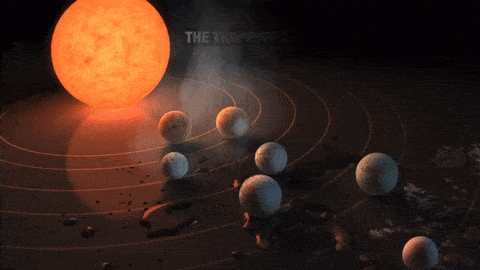
Formation of the Milky Way
Quiz
•
Science
•
8th - 12th Grade
•
Practice Problem
•
Medium
+2
Standards-aligned

Clint Sandford
Used 162+ times
FREE Resource
Enhance your content in a minute
20 questions
Show all answers
1.
MULTIPLE CHOICE QUESTION
45 sec • 1 pt

The Milky Way galaxy most likely formed
from collisions of larger galaxies.
from the big bang itself.
from collisions of smaller irregular galaxies.
from collisions of spiral galaxies.
2.
MULTIPLE CHOICE QUESTION
45 sec • 1 pt

Evidence for the Milky Way forming from collisions of smaller galaxies include
chaotic orbits of spiral arm stars.
chaotic orbits of the Sun and other disk stars.
chaotic orbits of halo stars.
variable stars in globular clusters.
3.
MULTIPLE SELECT QUESTION
1 min • 1 pt

Other evidence for Milky Way formation includes
orderly movement of disk stars.
only new star formation in the disk.
new star formation in the halo regions.
new stars in the halo region.
Tags
NGSS.MS-ESS1-2
4.
MULTIPLE CHOICE QUESTION
45 sec • 1 pt

How do the vast majority of stars orbit in the Milky Way?
in chaotic or random orbits
in orbits that are retrograde
in fixed or unchanging orbits
in mostly one direction around the central bulge
Tags
NGSS.MS-ESS1-2
5.
MULTIPLE CHOICE QUESTION
45 sec • 1 pt

How can astronomers "see" past the vast, light-obstructing dust clouds of the Milky Way?
By using the Hubble Space Telescope (HST).
By using visible light telescopes on the ground.
They make educated guesses.
By using ground-based radio telescopes.
Tags
NGSS.HS-PS4-3
6.
MULTIPLE CHOICE QUESTION
45 sec • 1 pt

What did astronomers discover about the structure of the Milky Way using radio studies?
it has many massive black holes
it has billions of stars
it has no real structure (irregular)
it has at least 5 major spiral arms
7.
MULTIPLE CHOICE QUESTION
45 sec • 1 pt

Our Sun (and solar system) lies in the _____ arm of the Milky way.
Perseus
Norma
Sagittarius
Orion
Tags
NGSS.MS-ESS1-2
Create a free account and access millions of resources
Create resources
Host any resource
Get auto-graded reports

Continue with Google

Continue with Email

Continue with Classlink

Continue with Clever
or continue with

Microsoft
%20(1).png)
Apple
Others
By signing up, you agree to our Terms of Service & Privacy Policy
Already have an account?
Similar Resources on Wayground

17 questions
Electricity Unit Test
Quiz
•
4th Grade - University

20 questions
Periodiek Systeem - toepassingen
Quiz
•
9th Grade

20 questions
7C Particles - ECAM
Quiz
•
7th - 10th Grade

20 questions
Force and Motion Quick Review
Quiz
•
8th Grade

15 questions
Cell Structure and Function Quiz
Quiz
•
12th Grade - University

15 questions
TLE 8 - Cleaning and Sanitizing Kitchen Tools
Quiz
•
7th - 8th Grade

16 questions
Development of The Cell Theory.
Quiz
•
8th Grade

15 questions
Cell Respiration
Quiz
•
9th Grade
Popular Resources on Wayground

10 questions
Honoring the Significance of Veterans Day
Interactive video
•
6th - 10th Grade

9 questions
FOREST Community of Caring
Lesson
•
1st - 5th Grade

10 questions
Exploring Veterans Day: Facts and Celebrations for Kids
Interactive video
•
6th - 10th Grade

19 questions
Veterans Day
Quiz
•
5th Grade

14 questions
General Technology Use Quiz
Quiz
•
8th Grade

25 questions
Multiplication Facts
Quiz
•
5th Grade

15 questions
Circuits, Light Energy, and Forces
Quiz
•
5th Grade

19 questions
Thanksgiving Trivia
Quiz
•
6th Grade
Discover more resources for Science

20 questions
Physical and Chemical Changes
Quiz
•
8th Grade

10 questions
Exploring Newton's Laws of Motion
Interactive video
•
6th - 10th Grade

20 questions
Balanced and Unbalanced Forces
Quiz
•
6th - 8th Grade

20 questions
Galaxies
Quiz
•
8th Grade

22 questions
Plate Tectonics
Lesson
•
6th - 8th Grade

10 questions
Unit 2: LS.Bio.1.5-LS.Bio.2.2 Power Vocab
Quiz
•
9th - 12th Grade

9 questions
Conduction, Convection, and Radiation
Lesson
•
6th - 8th Grade

20 questions
Life Cycle of a Star
Quiz
•
8th Grade



